Discover the Best Board Games for Every Player
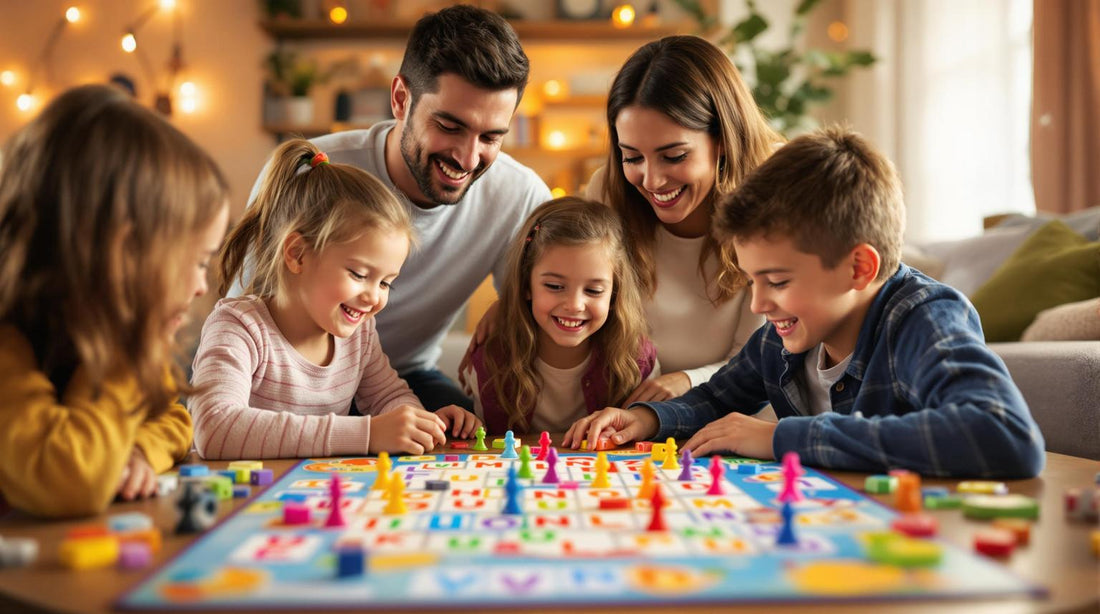
10 Best Spelling Board Games for Kids
Struggling to make spelling fun for your kids? These 10 spelling board games turn learning into an exciting and interactive activity that boosts vocabulary, memory, and confidence.
Fun Spelling Practice Games for Kids - 7 Ways To Play
Value Summary
These games cater to different age groups and skill levels, offering features like word-building, phonics practice, and even fast-paced challenges. From Scrabble Junior for beginners to Tapple for quick thinkers, there’s something for every learner. Plus, they help develop social skills like teamwork and turn-taking while making spelling practice enjoyable.
Quick Overview
Here are the top picks and their standout features:
- Scrabble Junior: Double-sided board for growing skills.
- Boggle Junior: Picture-word matching for early learners.
- Bananagrams: Fast-paced, crossword-style word play.
- Spelling Bee Game: Breaks down words into manageable parts.
- Zingo Word Builder: Bingo meets spelling with two difficulty levels.
- Quiddler Junior: Card game combining spelling and strategy.
- Sequence Letters: Letter matching with strategic gameplay.
- Scrabble Slam!: Quick card game for building four-letter words.
- Wordical: Combines spelling with basic math.
- Tapple: Vocabulary-building under a 10-second timer.
Why These Games?
- Educational Benefits: Improve spelling, vocabulary, and cognitive skills.
- Social Interaction: Encourages teamwork and communication.
- Fun and Engaging: Makes learning feel like playtime.
Ready to find the perfect game for your child? Let’s dive into the details of each one!
1. Scrabble Junior
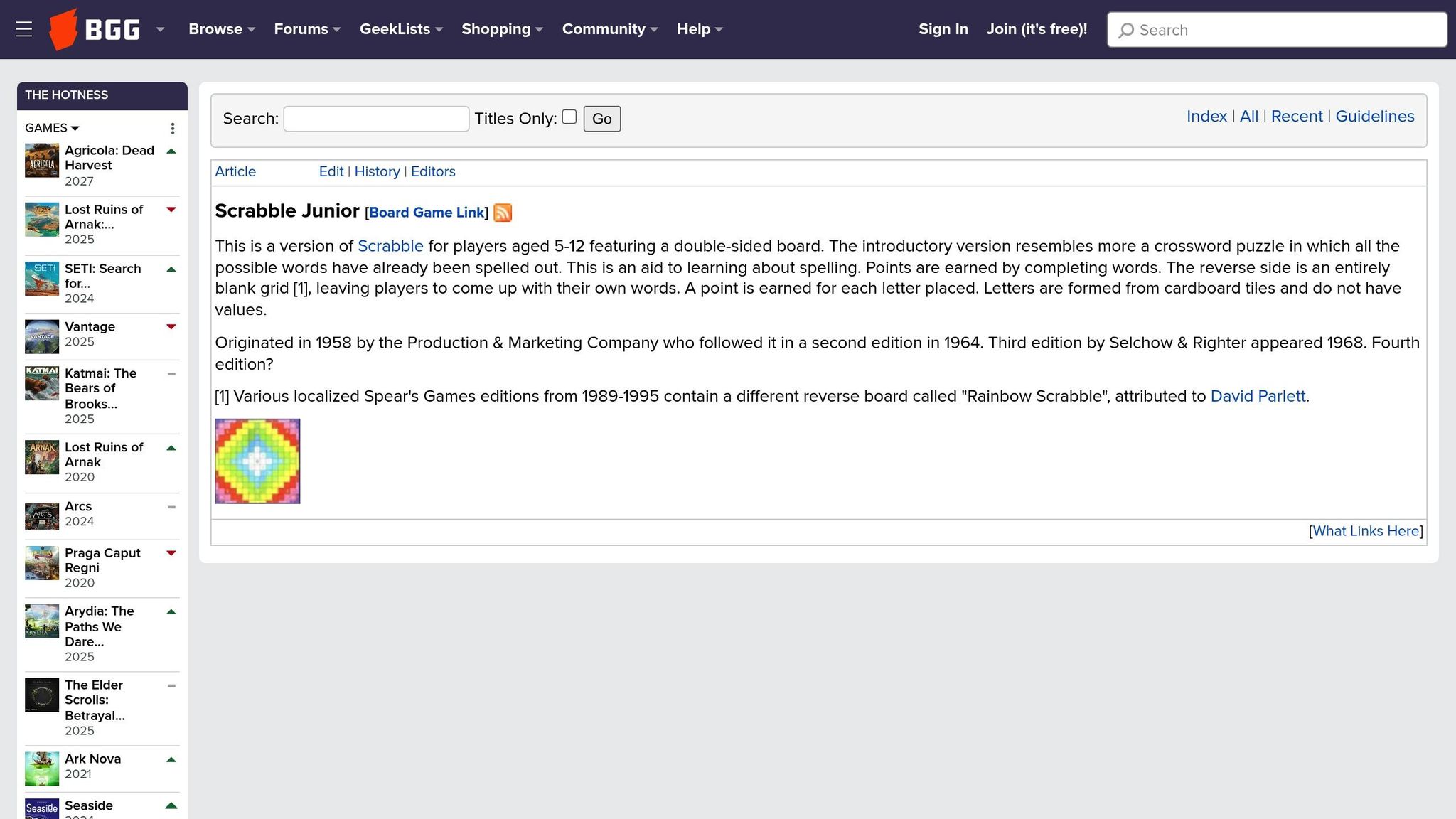
Scrabble Junior brings the well-loved word game to younger players, tailoring it for kids who are just starting to spell. Its double-sided board grows with your child's abilities, making it a great choice for early learners.
The game features a smaller 5×5 grid, which is much less intimidating than the 15×15 grid in regular Scrabble. With 105 letter tiles and 4 tokens, children ages 5–7 can easily manage the pieces while practicing their spelling.
One standout feature of Scrabble Junior is its two play modes, designed for different skill levels:
| Feature | Beginner Side | Advanced Side |
|---|---|---|
| Board Layout | Pre-filled crossword puzzle | Blank grid |
| Gameplay Focus | Matching letters | Creating words |
| Scoring System | Token placement | Points per letter |
| Suggested Age | 5+ | 6–7 |
This setup ensures the game can adapt to your child's learning pace, making it both fun and educational.
Unlike the competitive nature of the original Scrabble, this version focuses on cooperative play, helping kids feel more confident. It even includes a built-in dictionary so children can check word meanings and spellings as they play.
Scrabble Junior encourages critical thinking, planning, and reinforces essential skills like letter recognition, phonics, and basic spelling patterns. It’s a playful way to boost early literacy skills while keeping kids engaged.
2. Boggle Junior
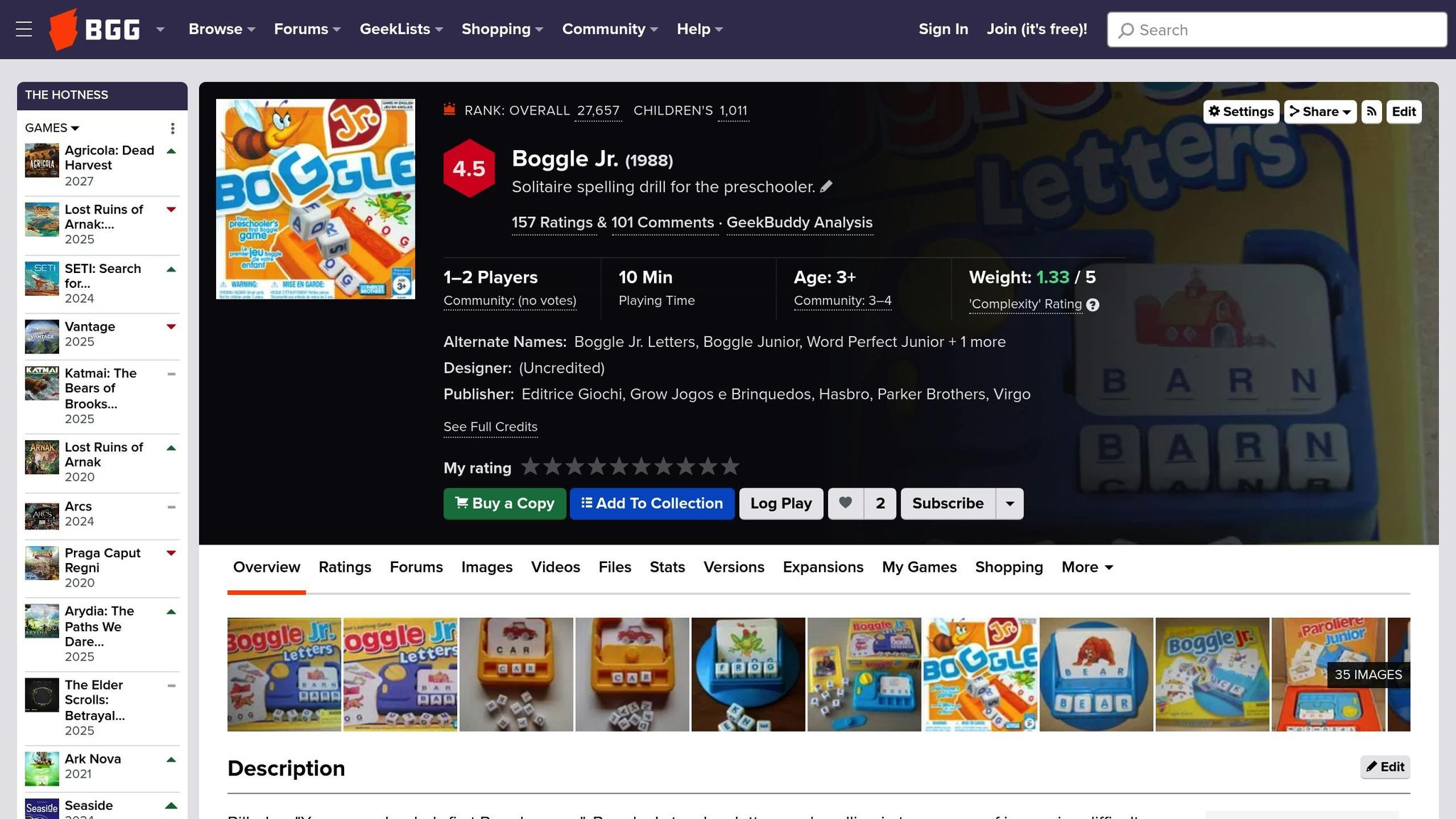
Boggle Junior transforms letter learning into an engaging activity for kids aged 3 and up. This simplified version of the classic game includes 8 large letter cubes and 30 picture/word cards featuring 60 words, making it perfect for young learners.
What makes Boggle Junior stand out? It offers two gameplay options tailored to your child's spelling skills:
| Game Mode | How to Play | Best For |
|---|---|---|
| Match It, Spell It | Match letter cubes to visible words | Beginners (ages 3-4) |
| Cover It | Spell words from memory | Advanced learners (ages 5+) |
The game is designed with small hands in mind, featuring a practical card and cube holder for easy use. At $21.99, it’s a great choice for helping kids build early literacy skills.
Parents have shared glowing reviews about its impact. Shannon from Raising Hooks says:
"My kids enjoy playing Boggle Junior together. It is great to see them working on spelling and reading as well as having fun!"
Melissa from Whole Heartily adds:
"This game will help children with their spelling in a fun, rewarding way!... I could see improvement in Zoey's word recognition and spelling almost immediately."
Tips for Playing:
- Say the letter sounds aloud while matching them to words.
- Add a timer for advanced players to make it more exciting.
- Reward kids for completing 3-letter and 4-letter words.
Boggle Junior isn’t just about spelling - it helps develop social skills like turn-taking and encourages independent learning. Plus, the letter cubes can be used separately for extra word-building activities, making it a versatile tool for early language development.
3. Bananagrams
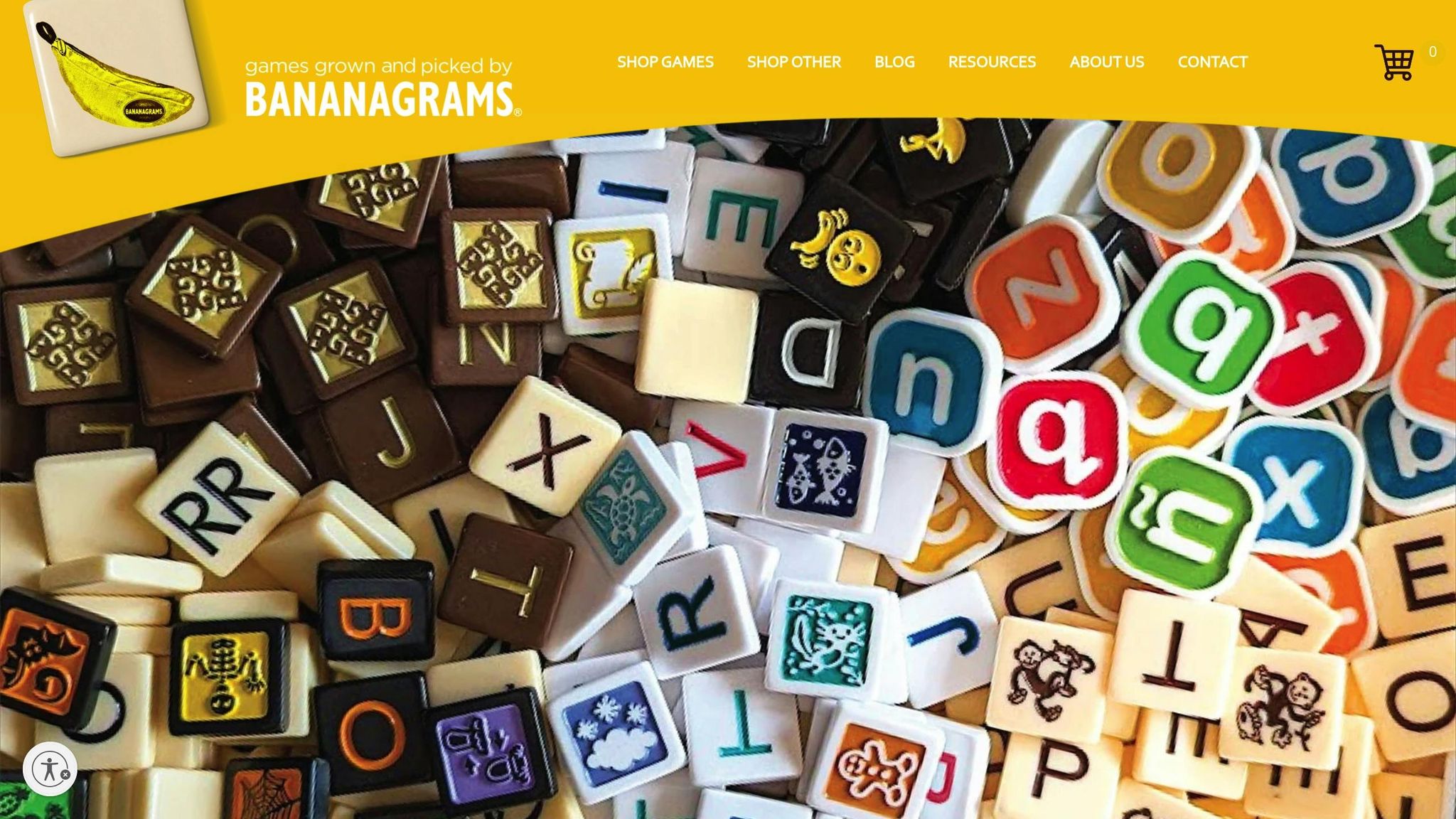
Bananagrams is a fast-paced, board-free word game designed for kids aged 7 and up. Using 144 letter tiles, players create interlocking crossword grids, making it a fun way to boost spelling and vocabulary skills - whether at school or at home.
The game helps kids develop a variety of skills, as shown in the table below:
| Skill Area | What Kids Gain |
|---|---|
| Language | Better word recognition, expanded vocabulary, improved spelling |
| Cognitive | Enhanced visual processing, memory recall, and sequential thinking |
| Social | Teamwork and good sportsmanship |
| Educational | Letter recognition, word formation, and classification skills |
Teachers often tweak the game to suit different skill levels, making it accessible for a range of learners.
Educators have seen positive results. Tatiana D. shared:
"Bananagrams has changed the way my students think about spelling and words."
Jessica S. noted that the game not only boosts spelling confidence but also promotes perseverance, teamwork, and sportsmanship.
To make Bananagrams work for younger players or beginners, try these simplified variations:
- Letter Explorer: Start with just 5 tiles to focus on identifying letter names and sounds.
- Word Builder: Use 3–11 tiles to form simple words.
- Speed Speller: Play with fewer tiles for a quicker game.
Tips for Parents:
- Encourage kids to say words aloud as they build them.
- Challenge older or advanced players to create longer, more complex words.
- Mix in nouns and verbs to broaden their vocabulary.
- Add time limits for an extra layer of difficulty.
Bananagrams turns spelling practice into a fun, interactive experience, helping kids build essential literacy skills while having a great time.
4. Spelling Bee Game
The Spelling Bee Game takes a fresh approach to spelling competitions by breaking down difficult words into smaller, easier-to-understand parts. This method blends learning with a sense of fun and competition, turning spelling practice into an engaging activity. Research supports this strategy, showing that dividing words into smaller components improves reading skills.
"Spelling bees help students break down large words into manageable chunks, and in doing so, they learn to read with greater comprehension." - Toronto-based elementary Montessori teacher Donna Paul
This technique strengthens various language skills, as shown in the table below:
| Learning Area | Benefits |
|---|---|
| Word Analysis | Understand word roots and origins |
| Reading Skills | Boost reading comprehension and vocabulary |
| Language Structure | Learn grammatical functions |
| Learning Strategy | Enhance cognitive and learning abilities |
Canadian spelling bee champion Jaden Zhang highlights the impact of this method:
"When you see the mind of the students as it click[s] for them, [when] they realize that it's just puzzle pieces, that's the moment I really love about teaching."
sbb-itb-1ed942f
5. Zingo Word Builder
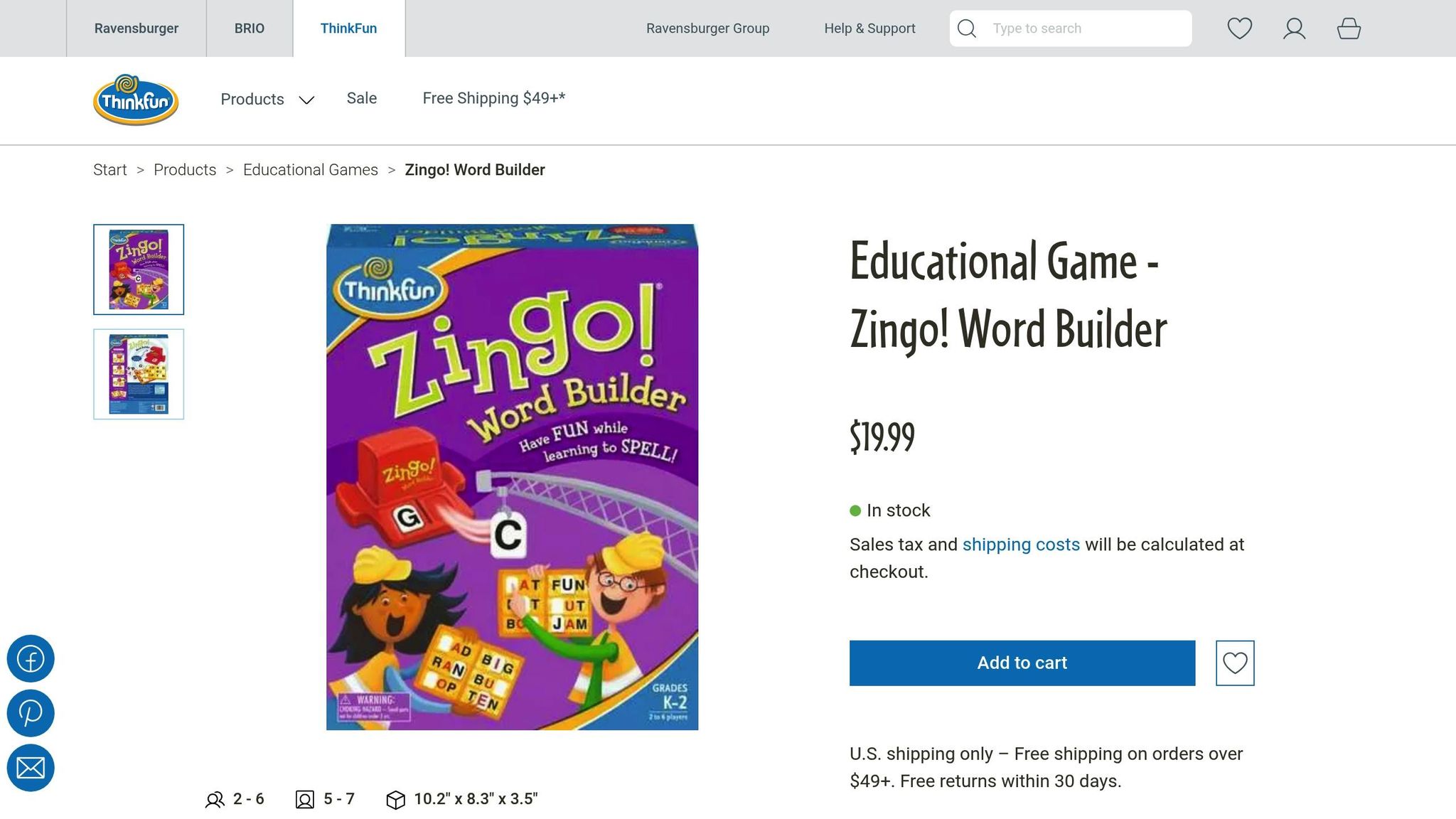
Zingo Word Builder turns bingo into a fun spelling adventure, combining the excitement of gameplay with spelling practice for kids aged 5 and up.
The game features double-sided cards with two difficulty levels, catering to various learning stages. It’s designed to strengthen literacy skills while ensuring the experience remains enjoyable.
| Side | Color | Challenge Level | Word Construction |
|---|---|---|---|
| Beginner | Yellow | Basic | Fill in one missing letter |
| Advanced | Orange | Intermediate | Complete words with two letters |
One of the game's standout elements is the 'Zinger' device, which randomly dispenses letter tiles, adding an element of surprise. It supports 2-6 players, making it a great choice for both classrooms and family game nights.
"Each double-sided card balances fairness and challenge." - Deanna Atkins, Editorial Assistant at Adventure Publishing Group
The gameplay isn’t just fun; it’s also educational. ThinkFun describes it as: "This word building version is great for players who are just learning how to put letters together to form words. With two levels of play, it’s perfect for engaging and supporting both beginner and more experienced readers!"
What’s Included?
- 1 Zing Zinger device
- 72 Letter Tiles
- 6 Double-sided Zingo cards
- Instructions
Educators praise the game for its ability to develop multiple skills at once. Brody Sheard notes, "Zingo! Word Builder is an educational game that kids really have fun playing! Zingo! definitely lives up to its educational claims."
This game is particularly well-suited for kindergarten through second-grade students. By focusing on three-letter words, it provides a solid foundation for early readers while keeping the experience fun and motivating.
6. Quiddler Junior
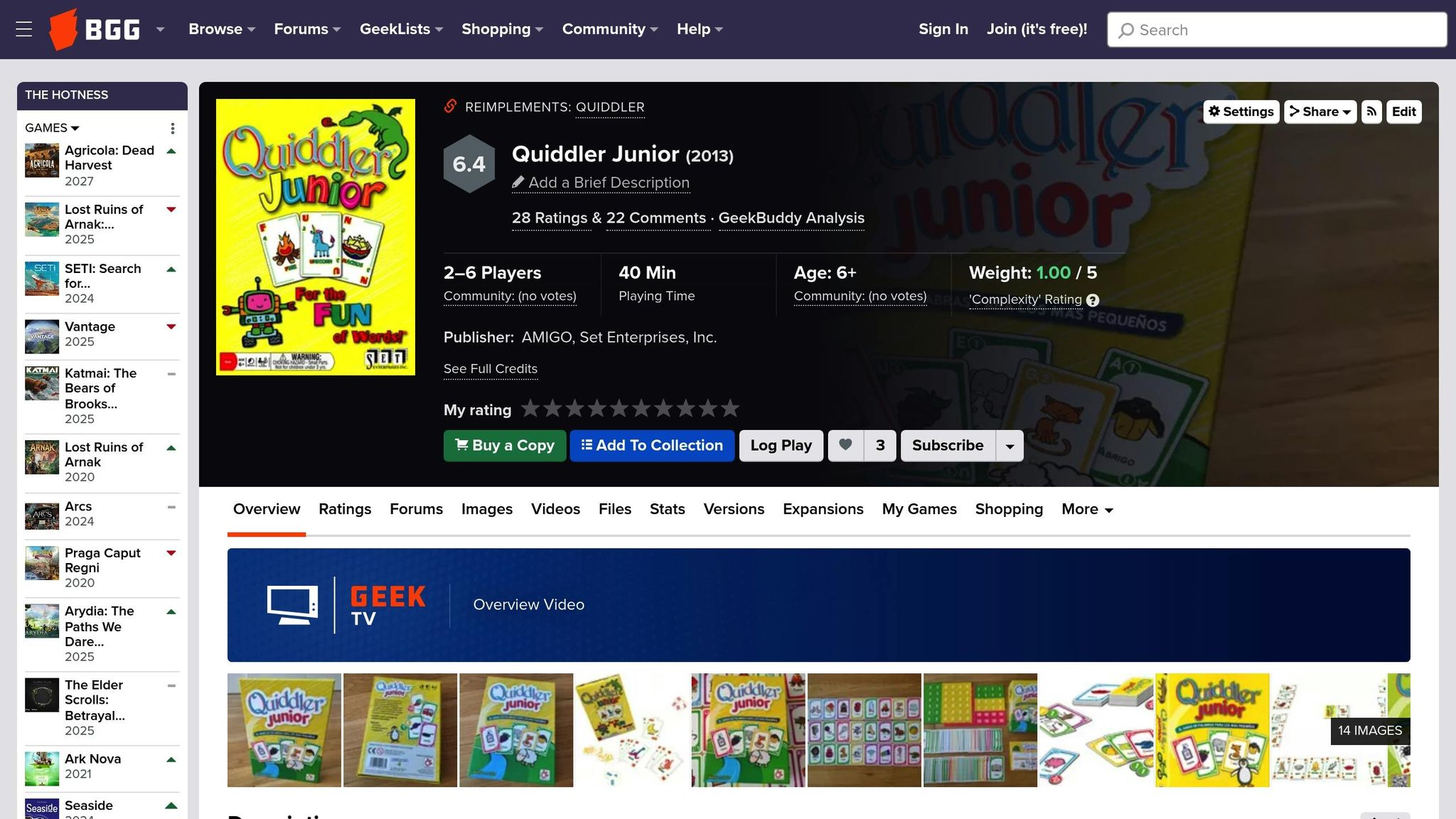
Quiddler Junior combines the fun of Rummy with the word-building challenge of Scrabble, creating an engaging card game for kids aged 6 and up. This interactive game turns spelling into a playful competition. Over six rounds, players get two to seven cards per round, with the increasing number of cards adding a fun twist to vocabulary practice.
Game Components and Features
Each card includes a letter or letter combination, an image, and an example word to make learning more intuitive.
Players draw and discard cards at the same time, racing to use all their letters to create a complete word. This gameplay reinforces common spelling patterns in a dynamic way.
Flexible Gameplay Options
For younger kids, teachers or parents can simplify the rules by focusing on the cards in hand, using just one draw pile, and skipping the 5-point bonus for the longest word.
The game is highly rated, earning 4.54 out of 5 stars on the PTPA Ratings Scorecard. Impressively, 100% of reviewers recommend it. Even some 4-year-olds enjoy playing the early rounds with fewer cards, making it a great choice for mixed-age groups.
Learning Through Play
Quiddler Junior helps kids practice letter combinations, recognize word patterns, and build their vocabulary with the help of visual cues. It also encourages strategic thinking and introduces basic math through scoring. This game is especially helpful for kids who are hesitant about spelling, turning practice into a fun family activity for 2–6 players.
7. Sequence Letters
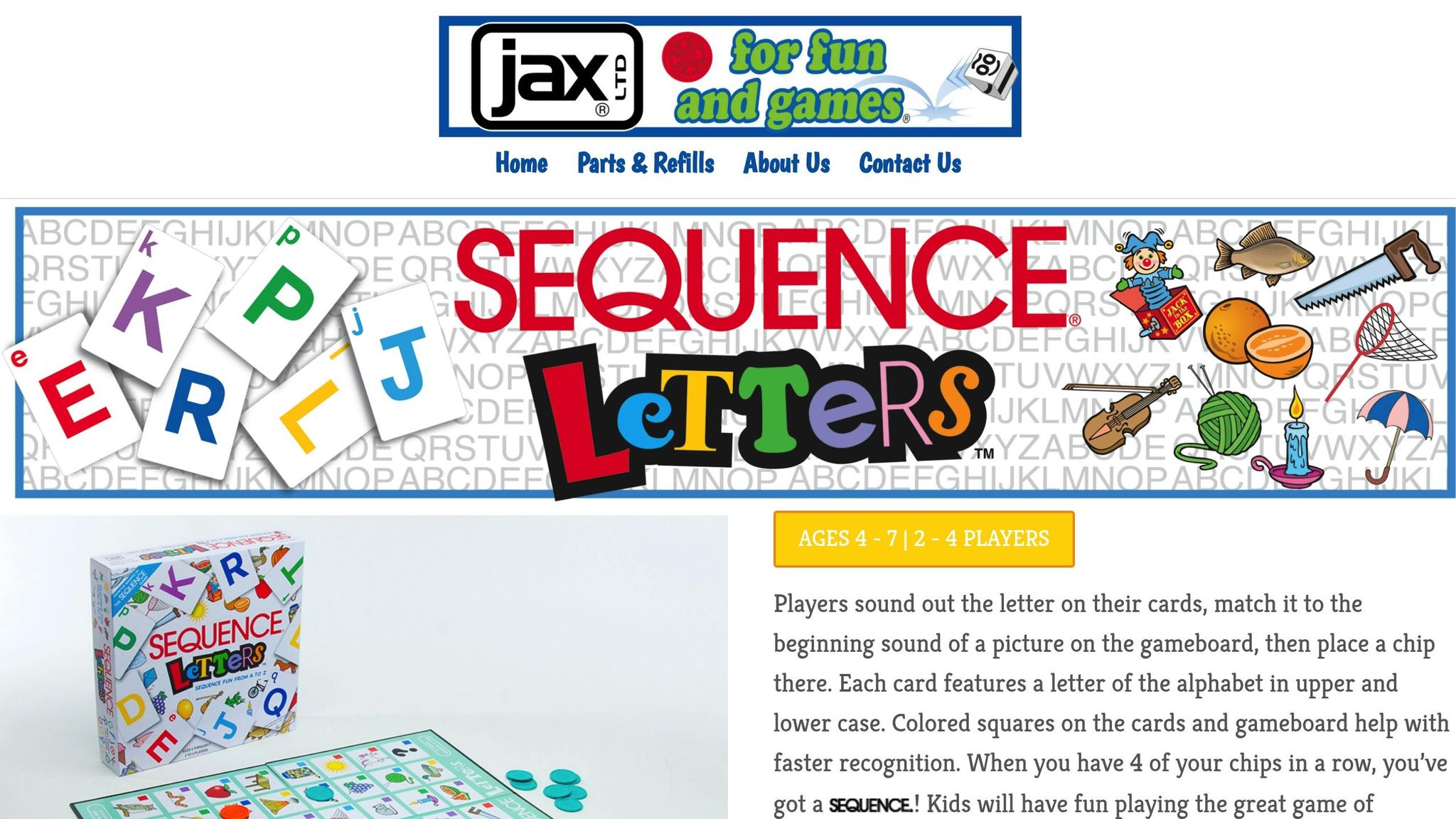
Sequence Letters is a spelling game that combines fun with learning. Perfect for kids aged 4–7, it encourages alphabet mastery while sharpening critical thinking skills.
Game Components and Setup
The game comes with:
- A game board
- 52 letter cards (two for each letter)
- 68 colored chips
- Wild cards (X and Z)
How to Play
Players match letter cards to pictures on the board to create a sequence of four chips. Both uppercase and lowercase letters are included to help kids recognize and differentiate them. The cards also feature color-coded squares that guide players to the correct board spaces, reinforcing visual matching skills.
Adding Strategy
The game isn’t just about matching letters - it’s also about planning. Players decide when to play their cards and how to use wild cards. The "X" card can remove an opponent’s chip, while the "Z" card lets players claim any open space.
What Kids Learn
Sequence Letters helps kids develop letter recognition, phonics, and strategic thinking. The color-matching aspect supports pattern recognition, while turn-taking builds social skills. Together, these elements lay a strong foundation for literacy.
8. Scrabble Slam!
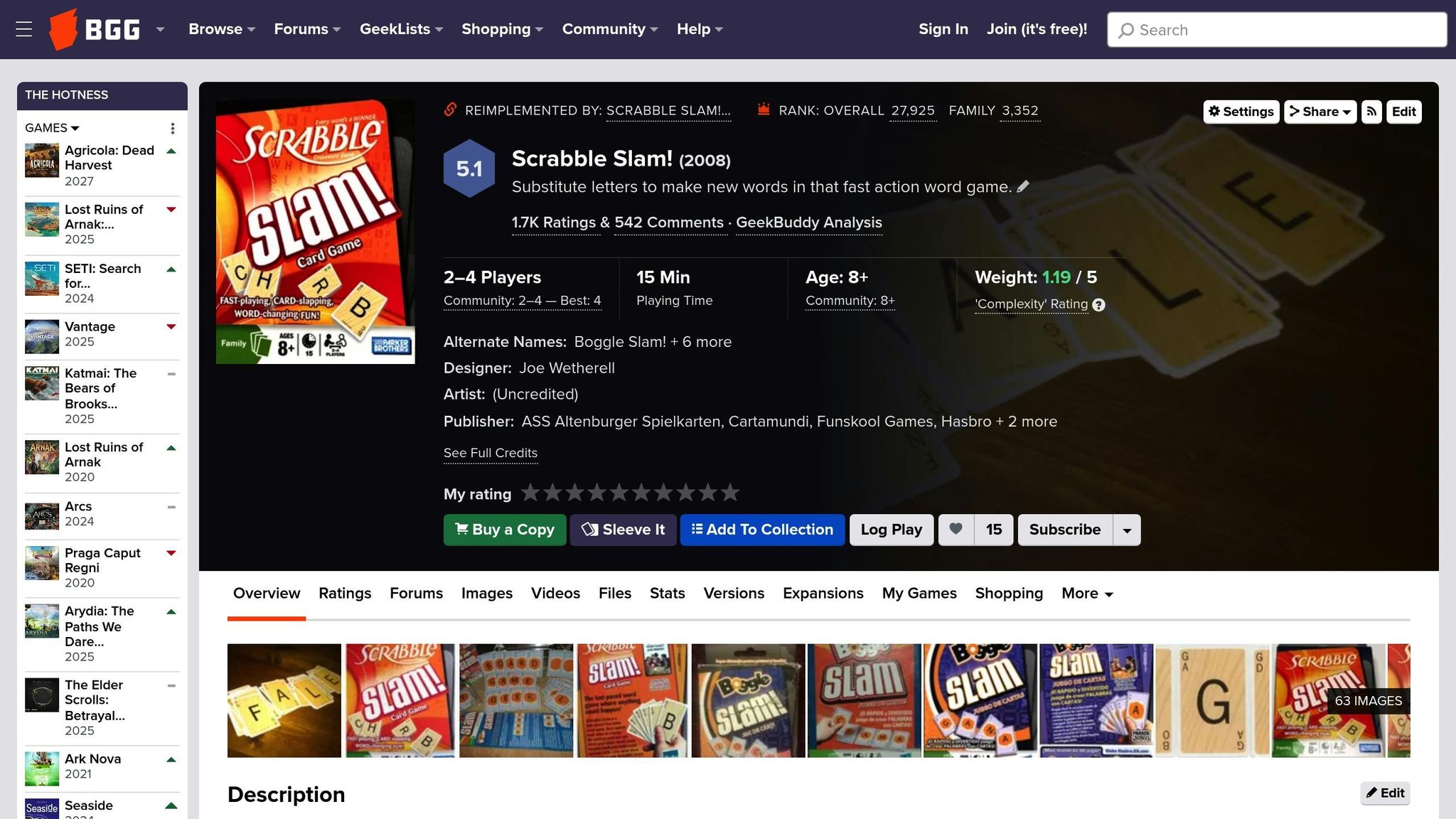
Scrabble Slam! is a lively card game that keeps kids entertained while helping them enhance their vocabulary. Designed for children aged 8 and up, it combines fun with learning.
Game Components
This game comes in two versions:
- Basic Edition: Includes 55 cards and supports 2–4 players.
- Deluxe Edition: Includes 84 cards and supports 2–6 players.
Each card has letters printed on both sides, and some cards feature a blank space that acts as a wild card.
How to Play
Start with a four-letter word placed in the center. Players then race to change one letter at a time to form a new valid four-letter word. For example, "CAKE" can become "TAKE", then "TAPE", and finally "TAME." All players play at the same time, making it a fast-paced challenge.
Game Rules
- Only standard English words are allowed.
- Slang, acronyms, proper names, hyphenated words, and words with apostrophes are not permitted.
- Players must agree on a dictionary for word verification.
Educational Benefits
Scrabble Slam! offers more than just entertainment. It helps kids develop:
- Quick thinking: The fast-paced format encourages players to think on their feet.
- Vocabulary growth: Forming valid four-letter words expands their word knowledge.
- Word recognition skills: Players practice identifying and altering words by changing a single letter.
The game’s design promotes learning while keeping things exciting, making it a solid choice for educational play.
Tips for Parents
Here are a few ways to make the game easier for younger kids:
- Play in teams to offer extra support.
- Use a dictionary suited to their age group for word verification.
- Keep sessions short - about 15 minutes is ideal.
Scrabble Slam! combines fast action with language-building benefits, making it a fun and educational addition to any family game night.
9. Wordical
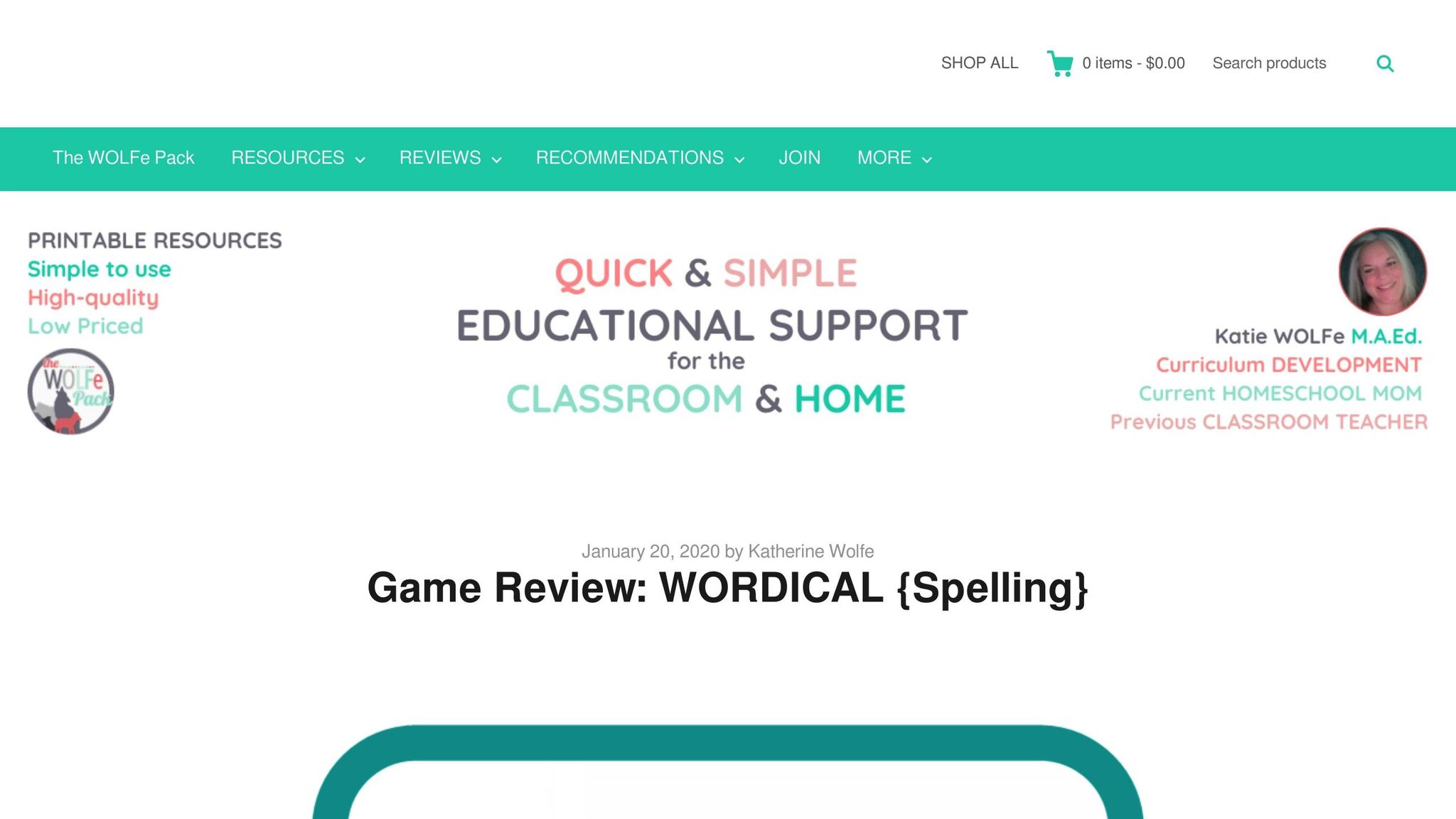
Wordical is a game that blends spelling and basic math, designed for 2–8 players aged 8 and up. Players roll vowel dice and combine them with consonant cards to create words and score points.
What's in the Box?
The game includes two main components:
- Vowel dice
- Consonant cards
How to Play
The gameplay is straightforward and educational, focusing on two key skills:
- Word Building: Players roll the vowel dice and use consonant cards to form words.
- Adding Points: Each word earns points, encouraging players to practice simple addition.
Why It's a Great Learning Tool
Wordical has been highly rated for its educational benefits and overall design:
| Category | Rating |
|---|---|
| Clarity | 5/5 |
| Educational Value | 5/5 |
| Fun Factor | 4/5 |
| Organization | 5/5 |
| Overall Score | 95% |
Flexible for All Ages
For older kids, the standard rules offer a solid challenge. Younger players can enjoy a simplified version, such as arranging the dice manually to make it easier.
Affordable Fun
Wordical is priced between $12.99 and $14.99, making it a budget-friendly option for educational play. If you're looking for more educational games, check out Brain Games (https://brain-games.com) for a variety of family-friendly options.
Helpful Tips for Playing
- Start with shorter words to build confidence.
- Decide on a quick competitive match or a slower-paced learning session.
- Double-check scores for accurate tallies.
Up next, explore Tapple - a high-energy game that takes wordplay to the next level!
10. Tapple
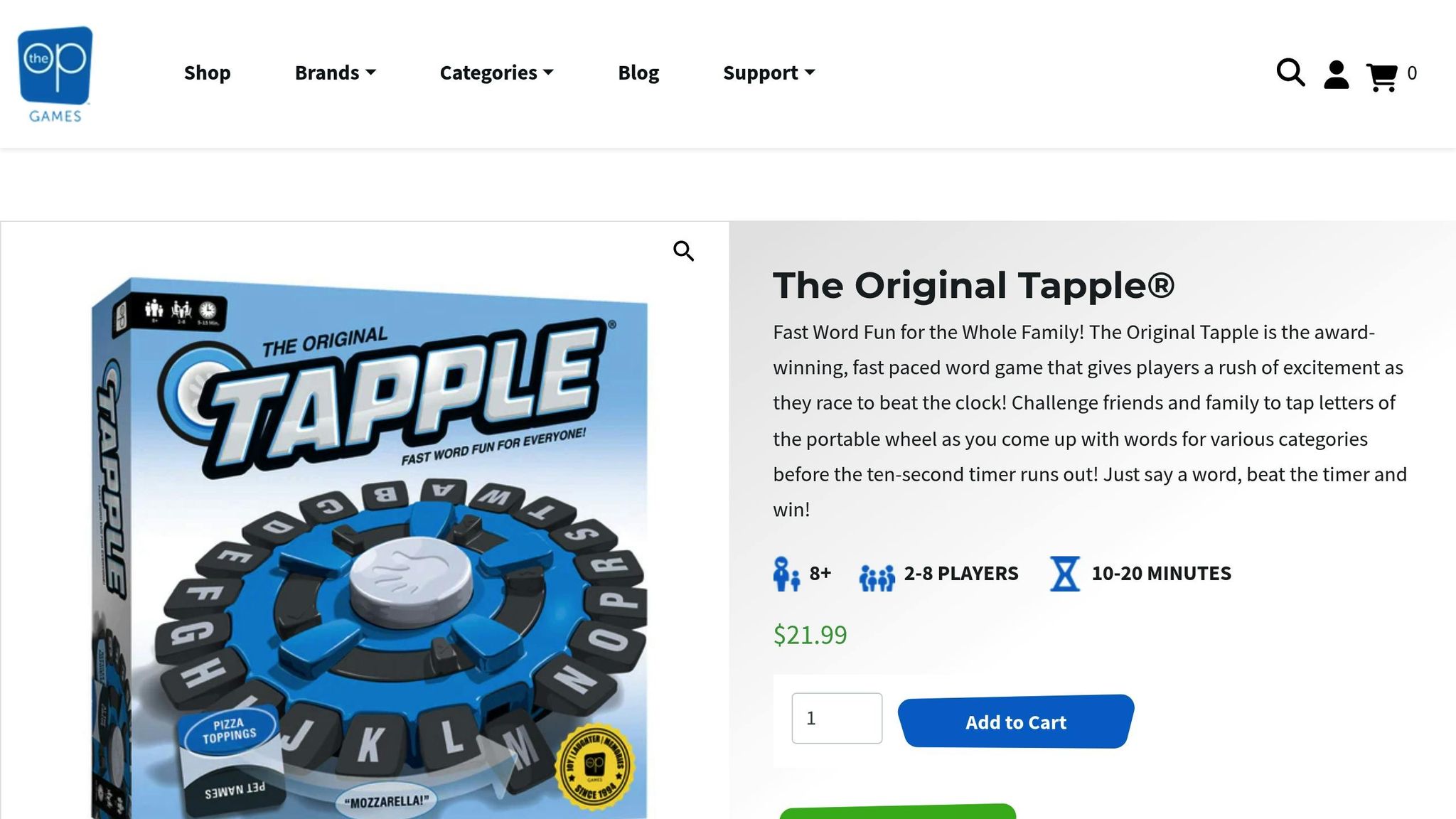
Tapple is a fast-paced word game centered around themed categories. It challenges players to think quickly and expand their vocabulary. With a 4.7 out of 5-star rating from over 8,531 Amazon reviews and a recommendation from Mensa, it’s a popular choice for both fun and learning.
Game Components
Tapple's setup includes:
- 20 letter buttons (excluding Q, U, V, X, Y, and Z)
- 144 category cards (36 cards in each of 4 categories)
- A 10-second electronic timer
- A compact, portable design for easy travel
How to Play
The gameplay is simple yet engaging. Players take turns following these steps:
| Step | Action | Time Limit |
|---|---|---|
| 1. Draw | Pick and read a category card | No limit |
| 2. Name | Say a word starting with an available letter | 10 seconds |
| 3. Press | Push the corresponding letter button | Immediate |
| 4. Reset | Restart the timer for the next turn | – |
Educational Benefits
Tapple strengthens language skills without requiring spelling. It helps players:
- Expand their vocabulary with varied category challenges
- Sharpen quick word recall under the pressure of a timer
- Practice clear and effective verbal communication
Quality Considerations
While Tapple is widely praised for being both fun and educational, some users have reported minor issues with letter buttons occasionally sticking. Handling the game gently and performing regular maintenance can help avoid these problems.
You can find Tapple at Brain Games (https://brain-games.com), along with other word games designed to support learning and development.
Why Choose Spelling Board Games
Spelling board games combine learning with fun and help build family connections while supporting literacy skills. Studies show that these games are a great way to encourage educational growth and strengthen relationships at the same time.
Educational Impact
Spelling and reading are closely linked and play a major role in early learning. Dr. Catherine Snow highlights this connection:
"Spelling and reading build and rely on the same mental representation of a word. Knowing the spelling of a word makes the representation of it sturdy and accessible for fluent reading"
This connection provides a strong base for several learning advantages.
Key Benefits for Children
| Category | How It Helps |
|---|---|
| Cognitive Skills | Improves memory, focus, and strategic thinking |
| Language Development | Expands vocabulary and strengthens spelling skills |
| Social Skills | Encourages teamwork and communication |
| Emotional Growth | Builds confidence and encourages healthy competition [3, 65] |
A Chance to Connect as a Family
In a world dominated by screens, spelling board games offer a refreshing way to spend quality time together. Clinical psychologist Dr. Beatrice Tauber Prior explains:
"Families are struggling to find the balance between digital and real-life connections, but board games provide a tool for that emotional connection to each other"
These games create a shared experience that brings families closer while keeping everyone engaged.
Catering to Different Learning Styles
Spelling board games work well for a variety of learning styles:
- Visual learners: Physical tiles help reinforce patterns.
- Kinesthetic learners: Hands-on play deepens understanding.
- Social learners: Group play encourages interaction.
- Reflective learners: The slower pace allows for thoughtful problem-solving.
Research also shows that kids who engage with educational tools like spelling games at least three times a week are twice as likely to recognize letters, identify sight words, and understand word meanings in context. This makes these games a great resource for both parents and educators.
Looking for more fun ways to learn? Check out Brain Games at Brain Games for a variety of options where education meets enjoyment.






